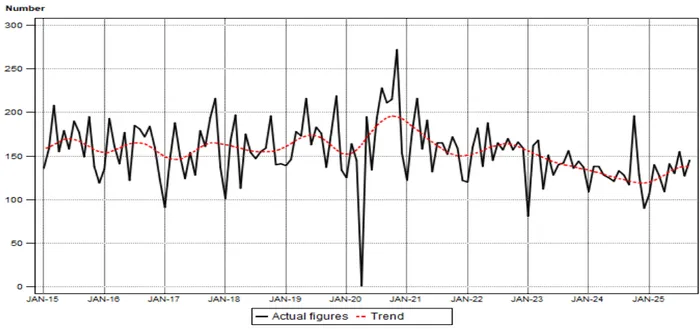SA's business liquidations rise: Finance, real estate and trade hardest hit

South Africa's corporate landscape is facing a daunting reality as the latest report from Statistics South Africa (Stats SA) reveals a concerning trend: in September 2025, 145 businesses were liquidated, pushing the cumulative year-to-date total to 1180 closures.
Image: File
The latest report from Statistics South Africa (Stats SA) reveals a concerning trend: in September 2025, 145 businesses were liquidated, pushing the cumulative year-to-date total to 1180 closures.
This marks an alarming 23.9% spike compared to the same month last year, with a 13% increase in liquidations during the July–September quarter. The statistics paint a stark picture of a nation grappling with an increasingly hostile economic environment.
The sectors hardest hit by this precipitous decline include finance, insurance, real estate, and business services, with trade, catering, and accommodation following closely behind.
Perhaps most strikingly, even major players are not immune; the high-profile liquidation of Murray & Roberts Holdings serves as a sobering reminder that the pressures facing South Africa's economy extend to industry giants.

The hardest-hit sectors include finance, insurance, real estate, and business services, followed closely by trade, catering, and accommodation
Image: Stats SA
Mounting pressures: why businesses are failing
The surge in liquidations can be attributed to a toxic combination of high interest rates, weak consumer demand, and rising operational costs. Logistical bottlenecks and increasing transportation costs further squeeze profit margins.
Compounding the crisis, global trade tensions and regulatory burdens continue to burden local enterprises.
A grim statistic reveals that one in four liquidations is attributable to unpaid debt. An overwhelming 80% of businesses report struggles in recovering outstanding debts, which can severely cripple cash flow and operational performance. In this precarious landscape, a single major debtor can place an entire business at risk.
The fragmented and inefficient debt collection system in South Africa adds yet another layer of uncertainty and strain on resources for struggling enterprises.
How businesses can prevent liquidations and job losses
To mitigate the risk of liquidation, especially as the festive season approaches, it is imperative for businesses to consider innovative solutions. Trade credit insurance stands out as a proactive measure against the repercussions of unpaid invoices and unstable debt collection.
“As businesses look towards the festive season, it is crucial that they recognise the importance of protecting their income streams and securing their financial stability,” emphasises Abdul Vally, CEO at Coface South Africa.
“By embracing trade credit insurance, businesses can fortify themselves against market uncertainties and thrive even in tough times.”
Trade credit insurance is designed to shield businesses from losses resulting from unpaid trade debts, allowing them to extend payment periods confidently to customers both domestically and internationally.
This coverage ensures invoices remain protected against excessive late payments or defaults, enabling companies to secure their cash flow, preserve margins, optimise income management, and maintain growth.
Assessing credit risks and protecting interests
In an era characterised by uncertainty, leveraging business intelligence and predictive analytics offers essential insights into the creditworthiness of customers and partners.
Understanding these parameters can minimise risks, providing companies a competitive edge.
“Businesses need to incorporate data-driven insights into their risk assessment processes,” explains Vally.
“By employing advanced analytics and predictive modelling, companies can identify potential risks early and implement proactive measures to mitigate them.”
The integration of robust risk management strategies with technological innovations enhances organisational resilience. By continually monitoring market trends, assessing counterparties' financial health, and detecting emerging risks, businesses can better navigate current challenges and safeguard long-term success.
Economic outlook: fragile confidence amid rising risks
Amid these grim liquidation figures, there are, however, glimmers of hope. South Africa's official unemployment rate has declined to 31.9% in Q3 2025, down from 33.2% in the previous quarter, and public-sector infrastructure investments are on the rise.
Yet, business confidence remains fragile; only four out of ten business leaders express satisfaction with prevailing conditions.
Coface South Africa urges all businesses, particularly small and medium enterprises (SMMEs), to take proactive steps: “Don’t wait until unpaid debts threaten your survival.
Protect your income streams, ensure your financial stability, and collaborate closely with your insurer. In these uncertain times, trade credit insurance is your shield against the storm,” concludes Vally.
BUSINESS REPORT